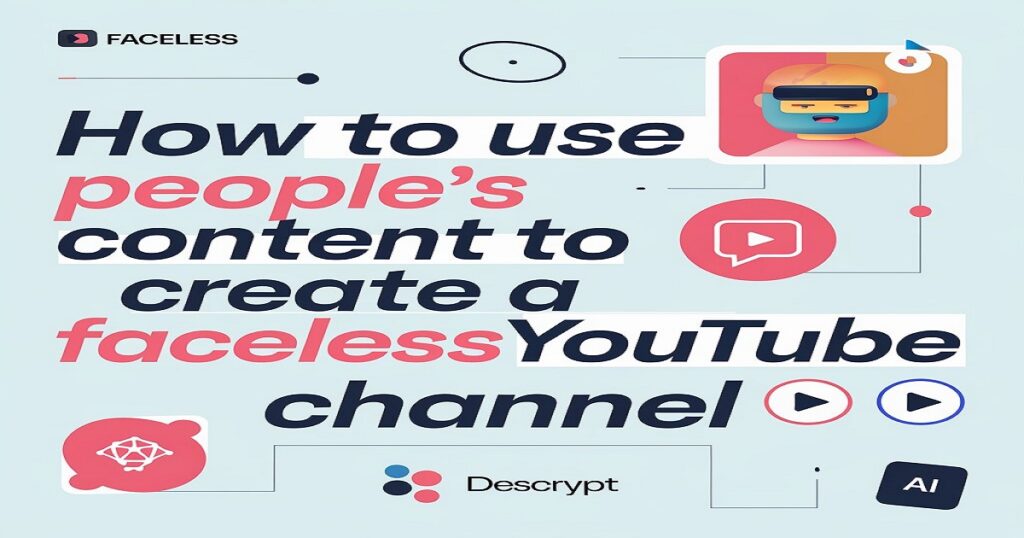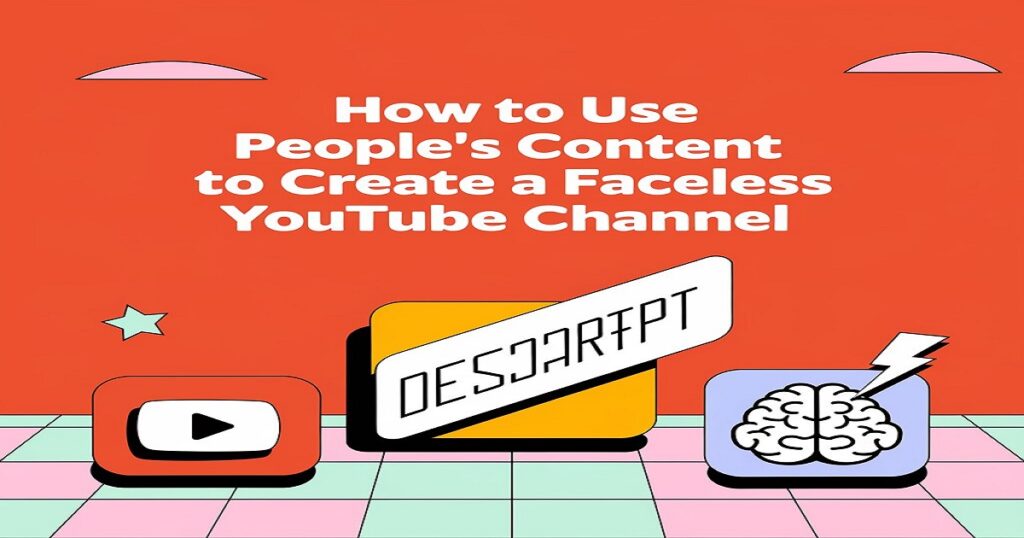The idea of a faceless YouTube channel is captivating, isn’t it? No need to be on camera, just compelling content and the possibility of earning income. But what if you’re not creating original footage? That’s where the question of how to use other people’s content to create a faceless YouTube channel comes in. It’s a nuanced topic, requiring careful consideration of copyright and fair use, but can be achieved successfully. Let’s dive into how beginners can make this work, focusing on ethical practices and, of course, monetization.
Table of Contents
The Appeal of the Faceless YouTube Channel
Before we tackle using other people’s content, let’s explore why faceless channels are so popular. They allow for:
Privacy: Many prefer not to show their face on the internet.
Flexibility: You can create videos anywhere, anytime, without worrying about your appearance.
Scalability: You can efficiently create videos using AI tools and existing content.
Niche Focus: Your content can speak for itself, without the distractions of a personality-driven channel.
This opens doors for a plethora of faceless YouTube channel ideas, ranging from educational compilations to relaxing nature scenes, and even animated storytelling.
Understanding “Other People’s Content”

When we talk about using “other people’s content,” we’re referring to material not created by you. This includes:
Video Clips: From documentaries, movies, news reports, etc.
Music: Both copyrighted songs and royalty-free music.
Images: Stock photos, creative commons images, etc.
Text: Quotes, news articles, summaries of books, etc.
Crucially, using other people’s content comes with copyright and usage implications. We can’t just use anything we find without permission or modification.
Legally Using Other People’s Content: Copyright and Fair Use
Fair Use: Fair use laws (which vary by country) allow for limited use of copyrighted material without permission, such as for commentary, criticism, education, or news reporting. This is complex; merely crediting the creator doesn’t make usage fair.
Transformative Use: One of the most effective ways to utilize content under fair use is to transform it. This means adding significant original value through your editing, narration, or commentary.
Attribution: Always, always, always attribute the original sources where applicable.
Creative Commons Licenses: Some creators release their work under creative commons licenses that grant certain usage rights, sometimes with attribution or specific usage conditions. Check these licenses carefully! Resources like Creative Commons have more on the different types.
Public Domain: Content where copyright has expired or never existed is in the public domain and free for use.
Remember, If in doubt about whether or not your usage is permissible, it is always best to seek express permission from the creator or not use the content.
Faceless YouTube Channel Ideas using other people content

Now, let’s explore content types you can use when implementing how to use other people’s content to create a faceless YouTube channel:
Compilations with Commentary: Curate clips related to a specific theme (e.g., funny animal videos, epic fails, vintage footage). Add your unique voiceover commentary, making it transformative.
Documentary-Style Explainer: Use snippets of existing educational videos to build engaging explanatory videos. For example, you could break down complex scientific topics or summarize historical events, using others’ content as supporting visuals while your original narration guides the viewer.
Reaction and Analysis Videos: Provide your reactions and analysis of other people’s content, adding personal insights and critiques.
“Best Of” Lists: Assemble the best clips, images, or examples on a topic, creating top 10 or top 5 lists with your commentary.
Study/Relaxation Backgrounds: Create visual backgrounds using royalty-free nature footage or time-lapses, set to royalty-free music, that can be used while studying or relaxing.
Animated Stories: Use AI-generated animations or public domain images to retell stories, create audio-visual books, or adapt historical events.
Curated News: Use clips from multiple news sources to compile a simplified overview of a particular news topic.
Product Reviews: Use clips from other people’s product review videos to create your own review summaries and overviews.
Summaries of Books: Combine a mix of creative common images, text and royalty free music to produce a summary of a book.
How to Create a Faceless YouTube Channel for Free
Creating a channel doesn’t need to break the bank. Here’s how you can get started:
Niche Selection: Decide what kind of content you’ll create. This will help you find the right content to reuse and stay focused.
Channel Setup: Create a YouTube channel using your Gmail account.
Content Gathering: Collect the videos, images, audio and text you need for your first few videos, keeping copyright guidelines in mind.
Video Editing Software: Use free tools like:
DaVinci Resolve
OpenShot
Shotcut
Audio Recording: Use a simple microphone for voiceovers. Audacity is a great free audio recording and editing tool.
Thumbnail Creation: Use Canva (free version) to design engaging thumbnails for your videos.
AI Tools: Several AI tools can help you simplify the whole process of creating your videos. Some include:
Descript
Murf
Pictory
Upload: Upload your first video and promote it across your networks.
Faceless Video AI Generator Free: Is it Possible?
There are numerous AI-powered tools that can significantly help in creating faceless videos. Some offer free plans, but they might have limitations. Here are some examples of what AI can do:
AI Video Generators: Generate short video clips based on prompts (often used as B-roll).
AI Text-to-Speech: Create realistic voiceovers without using your own voice.
AI Art Generators: Generate visual content.
AI Music Generators: Create royalty-free music.
Explore tools such as RunwayML, Synthesia, and Lumen5, but be mindful of the terms of use for their free versions. As AI technology rapidly develops, there are more free tools, but a budget may be needed if you require premium AI features.
Faceless YouTube Channel Monetization: Making it Profitable

So you’ve created content, but how do you make money with a faceless YouTube channel? Here are ways to consider for your faceless YouTube channel monetization:
YouTube Partner Program (YPP): This is the primary way to monetize on YouTube. To join, you need:
1,000 subscribers
4,000 valid public watch hours in the past 12 months.
Affiliate Marketing: Promote products or services within your videos using affiliate links. When viewers purchase through your links, you earn a commission.
Merchandise: If your channel gains a loyal audience, consider creating merchandise (t-shirts, mugs, etc.) branded with your logo or channel theme.
Sponsorships: If you have a good sized audience, you can work with businesses to promote their products within your videos.
Patreon or Similar Platforms: Offer exclusive content and perks to your most dedicated viewers for a monthly membership fee.
Selling Digital Products: Develop resources related to your niche and sell them to your audience, including e-books, courses, templates, or presets.
Faceless Channel Monetization: Key Strategies
Monetization requires a strategic approach. Here are some key strategies for faceless channel monetization:
Consistency: Upload videos regularly to keep your audience engaged.
Quality Content: Ensure your content is informative, entertaining, or useful.
SEO Optimization: Use relevant keywords in your titles, descriptions, and tags to improve search visibility.
Audience Engagement: Respond to comments, ask questions, and build a community around your channel.
Analyze Your Data: Use YouTube Analytics to understand what’s working and what’s not, and adapt your strategy accordingly.
Faceless YouTube Channel Examples
Let’s look at some real-world examples of successful faceless YouTube channels that may or may not use other people content:
Top 10s or 5s channels : Channels that make list type videos.
Relaxing Backgrounds: Channels that use nature or other stock footage for studying or relaxation.
Educational Channels: Some educational channels use animated visuals and voiceovers.
Gaming Channels: Channels using pre-recorded gameplay and voiceovers without the person on camera.
Animation Channels: Channels using animation and voiceovers.
100+ Faceless Youtube Channel Ideas
There are many options out there for faceless Youtube Channel Ideas. Think of what interests you, and start there. Here are some ideas to get you started:
Relaxing Nature Videos
Ambient Soundscapes
Documentary Summaries
Motivational Quotes and Graphics
ASMR Content
Study With Me Videos
Educational Animations
Book Summaries
History Lessons
Science Explanations
Cooking Tutorials (using hands)
Crafts and DIY Guides (using hands)
AI Art Animations
Gaming Tutorials
Tech Reviews
Top 10 Lists on Various Topics
Motivational Speeches
Travel Videos
Financial Guides
Gardening Tutorials
Home Improvement Videos
Photography Tips
Music Theory Lessons
Language Learning
Meditation Guides
Sleep Stories
Funny Video Compilations
Epic Fail Compilations
Pet and Animal Videos
Automotive Reviews
Movie Reviews
TV Show Summaries
Video Game Reviews
Technology Tutorials
Coding Tutorials
Website Reviews
Software Tutorials
Product Comparisons
News Summaries
Historical Analysis
Political Commentary
Business Insights
Marketing Tips
Social Media Growth Strategies
Personal Development Advice
Relationship Advice
Parenting Guides
Nutrition and Diet Guides
Fitness Routines
Yoga and Pilates Guides
Home Decor Ideas
Fashion Tips
Beauty Tutorials
Makeup Tips
Skincare Routines
Hair Care Tutorials
Astrology Readings
Tarot Card Readings
Spiritual Guides
Mindfulness Exercises
Motivational Stories
True Crime Cases
Mystery Stories
Science Fiction Stories
Fantasy Stories
Historical Fiction Stories
Animated Short Films
Original Music Compositions
Sound Effects Libraries
Voiceover Demos
Poetry Readings
Creative Writing Prompts
Drawing Tutorials
Painting Guides
Sculpting Tutorials
Calligraphy Tutorials
Origami Tutorials
Knitting and Crocheting Guides
Woodworking Tutorials
Jewelry Making Guides
Candle Making Tutorials
Soap Making Guides
Pottery Tutorials
Baking Tutorials
Recipe Compilations
Restaurant Reviews
Coffee Brewing Guides
Tea Brewing Guides
Cocktail Recipes
Smoothie Recipes
Healthy Meal Prep
Travel Guides for Destinations
City Tours
Nature Walks
Virtual Museum Tours
Art Gallery Tours
Street Art Documentaries
Urban Exploration Videos
Abandoned Place Tours
Space Exploration Videos
Marine Life Documentaries
Wildlife Documentaries
Astronomy Tutorials
Meteor Showers Videos
Science Experiments
Conclusion
Creating a faceless YouTube channel using other people’s content can be a successful venture. However, it requires a careful approach, ethical practices, and a commitment to creating engaging content. If you are strategic, understand copyright laws, and are open to learning new skills, the world of faceless YouTube awaits you, opening doors to new creative and financial possibilities. The process of how to use other people’s content to create a faceless YouTube channel is complex but achievable for beginners!
By combining the resources available, a desire to create great content and ethical practices, you too can embark on the journey of starting your own faceless Youtube Channel and the possibilities that come with it.
If you want to scale up your Youtube Channel, here are other related links
[What Are Trending Niches for Faceless Educational Content in 2025].
[Top AI Tools to Create a Faceless YouTube Channel]
[How to Write Engaging Scripts for Faceless YouTube Videos].
Frequently Asked Questions
Is it legal to use other people’s content on my faceless YouTube channel?
It depends on how you use it. Using copyrighted content without permission is generally illegal. However, there are exceptions like “fair use,” where you can use copyrighted material for commentary, criticism, education, or news reporting. You also need to consider Creative Commons licenses and public domain content, which allow for certain types of usage with proper attribution. To stay safe, seek explicit permission if you’re not sure. It’s always better to err on the side of caution and create original content whenever possible.
Can I monetize my faceless YouTube channel even if I don’t create original videos?
Yes, you can monetize, but it requires more effort, and careful planning. You need to understand what constitutes “transformative use” in your video content if using other people’s videos, and how to add significant original value through your own commentary, editing, and narration. You also need to focus on building a valuable channel. While direct monetization through the YouTube Partner Program requires 1,000 subscribers and 4,000 watch hours, you can also monetize through affiliate marketing, merchandise sales, and sponsorships if you have an engaged audience.
What are some faceless YouTube channel ideas that don’t involve showing my face?
There are endless ideas! You could create compilation videos with commentary (like “best of” lists or funny moments), documentary-style explainer videos using existing footage, animated storytelling, reaction videos, relaxing background videos, or even study sessions set to music. The key is to find a niche that interests you and allows you to use other people’s content in a transformative and ethical way.
Do I need to pay for expensive video editing software to create a faceless YouTube channel?
No, you don’t! There are many free and powerful video editing tools available for beginners. Software like DaVinci Resolve, OpenShot, and Shotcut are all great options to get started. You can also find free audio recording and editing tools like Audacity, and create amazing thumbnails on Canva (free version). You may decide to explore premium AI tools which may require a budget.
How can AI help me in creating a faceless YouTube Channel?
AI tools can significantly streamline your faceless video creation process. They can generate short video clips, create realistic text-to-speech voiceovers, produce AI art and graphics, and even compose royalty-free music. While some tools offer free plans, they may have limitations. Popular tools include RunwayML, Synthesia, and Lumen5 which can greatly simplify content creation. Always be sure to understand and abide by the terms of service for the AI tools you use.
Can I Monetize My YouTube Channel Without 1000 Subscribers?
Direct monetization through the YPP requires 1,000 subscribers and 4,000 watch hours. However, you can use other avenues like affiliate marketing, selling your own digital products, or offering coaching services even without reaching these benchmarks. Building your audience is the first step to a successful channel.
What Happens When You Monetize Your YouTube Channel?
Once accepted into the YPP, you’ll start seeing ads on your videos. You’ll earn a share of the advertising revenue based on several factors, including the number of ad impressions. It’s important to note that this is a continuous process. If you violate YouTube’s community guidelines, your monetization can be disabled.
For more captivating and related post, click here


1 thought on “How to Use People’s Content to Create a Faceless YouTube Channel”